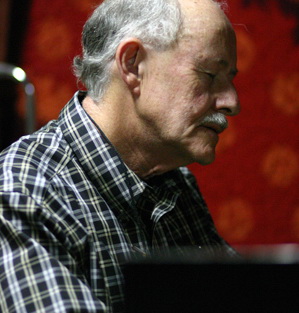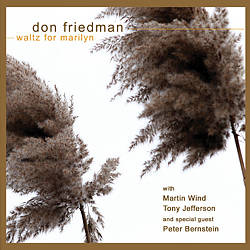Autumn Colors – Don Friedman
This light-toned modal song combines a simple, subtle melody and a driving bass ostinato. Don's solo piano arrangement is available; it's based on what he plays on the recording.
- Recording: Don Friedman - Waltz For Marilyn
- Recorded on: March 3 & 4, 2007
- Label: Jazz Excursion (110)
- Concert Key: G minor, No key center
- Vocal Range: , to
- Style: Even 8ths (medium)
- Guitar - Peter Bernstein
- Piano - Don Friedman
- Bass - Martin Wind
- Drums - Tony Jefferson
0:00
0:00
Buy MP3
Purchase Autumn Colors - Don Friedman
Purchasing this song through our affiliate links with certain retailers provides jazzleadsheets.com with additional support to help keep us bringing you the best lead sheets available. Thank you!
Video
- Description
- Historical Notes
- Solos
- Piano Corner
- Bass Corner
- Drum Corner
- Guitar Corner
- Inside & Beyond
- Minus You
With its open-ended melody and modal harmonic structure, this song evokes a particular autumnal palette—perhaps the pale, muted browns seen on the "Waltz For Marilyn" album cover. Autumn Colors is a simple but subtle song anchored with a rhythmic two-measure bass ostinato which continues for the whole head. The groove is not specifically Latin or funky, shown on our lead sheets as simply "even 8ths." The melody of this 32-measure song uses a single four-measure theme, played twice each in G minor, E♭ minor, C minor, and G minor again. The second repeat of the theme in each key has one subtle difference from the first: the minor 7th is replaced with a major 7th. There are melody pickups leading into the C (C minor) and D (G minor) sections; in these measures before the start of the sections, the bass line changes and implies a passing chord which is shown in brackets. On the recording the piano does not play these passing chords.
The solo changes are slightly different, with passing chords—mostly II-V7s—at the end of each section. In the solos on the recording, the bass plays a loose 2-feel based on the ostinato from the head. There is an intro that starts with solo piano playing the bass line for eight measures, with the bass and drums joining for eight more measures. The intro bass line is vamped for a drum solo before the out head, and the end vamps the bass line again.
A two-stave Piano and Bass part is available that shows the melody with the bass ostinato. We also have Don's solo piano arrangement, which shows the voicings; click on the Piano Corner tab for more details.
Check out Don's articulation of the bass line on the recording. He really plays the eighth notes short on beat 3 of the first measure, giving the bass line a particular rhythmic drive. Our C treble clef lead sheet is written for guitar in the higher octave, as played by Peter Bernstein on the recording.
The solo changes are slightly different, with passing chords—mostly II-V7s—at the end of each section. In the solos on the recording, the bass plays a loose 2-feel based on the ostinato from the head. There is an intro that starts with solo piano playing the bass line for eight measures, with the bass and drums joining for eight more measures. The intro bass line is vamped for a drum solo before the out head, and the end vamps the bass line again.
A two-stave Piano and Bass part is available that shows the melody with the bass ostinato. We also have Don's solo piano arrangement, which shows the voicings; click on the Piano Corner tab for more details.
Check out Don's articulation of the bass line on the recording. He really plays the eighth notes short on beat 3 of the first measure, giving the bass line a particular rhythmic drive. Our C treble clef lead sheet is written for guitar in the higher octave, as played by Peter Bernstein on the recording.
For more from "Waltz For Marilyn," check out the title track. This is the second recording of Autumn Colors; Don played a solo piano version on his 2006 album "Moon River: New York Monologue." "Waltz For Marilyn" was Don's only recording with guitarist Peter Bernstein.
This song is built on a driving bass line in the left hand, with a steady melodic pattern in the right hand. The melody pattern consists of sustained chords connected by short ascending eighth-note lines. It's a very peaceful song, with a catchy, intimate vibe that's easy for listeners to connect with.
Don's Solo Piano Arrangement has the same right hand voicings on the long notes of the melody that he plays on the recording. Each of these voicings is a third on top of a second, for example (top to bottom) D-B♭-A for the first one. The left hand continues the bass ostinato throughout. Pedal markings are included; the second measure of the bass ostinato is pedaled. The ending adds an extra little bit of melody that winds down to the final left hand notes.
Don's Solo Piano Arrangement has the same right hand voicings on the long notes of the melody that he plays on the recording. Each of these voicings is a third on top of a second, for example (top to bottom) D-B♭-A for the first one. The left hand continues the bass ostinato throughout. Pedal markings are included; the second measure of the bass ostinato is pedaled. The ending adds an extra little bit of melody that winds down to the final left hand notes.
Guitarist Peter Bernstein is featured on the melody of this song, playing unison with pianist Don Friedman. Our C treble clef lead sheet is in the written octave for guitar, where Peter plays the melody on the recording. Check out how his solo begins - simple like the melody, but using his unique expressive phrasing. Peter and Don improvise together briefly on the coda.
Related Songs
Email Send Autumn Colors to a friend
Send this page to a friend via email. Add your name or email in the first field. In the second, add one or more email addresses, separated by a comma.

Don Friedman
May 4, 1935 – June 30, 2016
Don Friedman was only four years old, living in San Francisco, when he started playing his parents' piano. A year later, he started lessons with a private teacher. His love for jazz music was born when he moved to L.A. and heard the likes of Les Brown and Lee Konitz for the first time. Read more...
There was a problem.
...

